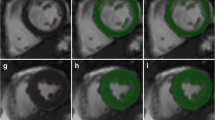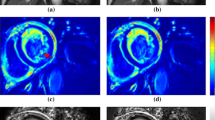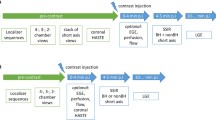Abstract
Global left ventricular function is a prognostic indicator and is used to evaluate therapeutical interventions in patients with heart failure. Regional left ventricular function can be determined with tagged MRI. Assessment of global left ventricular function using the tagging data may have additional clinical value without incurring extra scanning time, which is currently a limiting factor in cardiac imaging. Direct determination of end-diastolic volume is not possible with conventional tagged MRI. However, end-systolic volume can be directly measured because myocardium–blood contrast improves through a tagged image series. We investigated the potential of tagged MRI using frequency-domain analysis software to retrospectively track end-diastolic contour from end-systolic contour and subsequently calculate the ejection fraction. Tagged MRI was compared with the standard bright-blood cine MRI in healthy volunteers (n=20) and patients with previous myocardial infarction (n=8). Left ventricular ejection fraction derived from tagged MRI is linearly correlated to left ventricular ejection fraction obtained by standard cardiac cine MRI (y=1.0x+1.31, r>0.98, p=0.014). In addition, the inter-observer and intra-observer coefficient of variation for left ventricular ejection fraction measurements was low (CVintra=0.4%, CVinter=1.3%). With tagged MRI, only end-systolic volume needs to be manually determined, and accurate estimation of left ventricular ejection fraction is obtained because end-diastolic and end-systolic volumes are determined using identical anatomical points. Our data indicate that tagged MRI can be used to quantitatively assess both regional and global left ventricular function. Therefore, tagged MRI may be a valuable clinical tool for determining the prognosis and evaluating the effect of therapeutical intervention using a single imaging session in patients with left ventricular dysfunction.


Similar content being viewed by others
References
Haider AW, Larson MG, Benjamin EJ, Levy D (1998) Increased left ventricular mass and hypertrophy are associated with increased risk for sudden death. J Am Coll Cardiol 33:1454–1459
CIBIS-II Investigators and Committees (1999) The cardiac insufficiency bisoprolol study II (CIBIS-II): a randomized trial. Lancet 353:9–13
Bouton S, Yang A, McCrindle BW, Kidd L, McVeigh ER, Zerhouni EA (1991) Differentiation of tumor from viable myocardium using cardiac tagging with MR imaging. J Comput Assist Tomogr 15:676–678
Geskin G, Kramer CM, Rogers WJ, et al. (1998) Quantitative assessment of myocardial viability after infarction by dobutamine magnetic resonance tagging. Circulation 98:217–223
Vaduganathan P, He ZX, Vick GW III, Mahmarian JJ, Verani MS (1999) Evaluation of left ventricular wall motion, volumes, and ejection fraction by gated myocardial tomography with technetium 99m-labeled tetrofosmin: a comparison with cine magnetic resonance imaging. J Nucl Cardiol 6:3–10
Missouris CG, Forbat SM, Singer DRJ, Markandu ND, Underwood R, MacGregor G (1996) Echocardiography overestimates left ventricular mass: a comparative study with magnetic resonance imaging in patients with hypertension. J Hypertens 14:1005–1010
Croisille P, Revel D (2000) MR imaging of the heart: functional imaging. Eur Radiol 10:7–11
Bogaert J, Maes A, Van de Werf F et al (1999) Functional recovery of subepicardial myocardial tissue in transmural myocardial infarction after successful reperfusion: an important contribution to the improvement of regional and global left ventricular function. Circulation 99:36–43
Zerhouni EA, Parish DM, Rogers WJ, Yang A, Shapiro EP (1988) Human heart: tagging with MR imaging. A method for noninvasive assessment of myocardial motion. Radiology 169:59–63
Axel L, Dougherty L (1989) Heart wall motion: improved method of spatial modulation of magnetization for MR imaging. Radiology 172:349–350
Gyngell ML (1988) The application of steady-state free precession in rapid 2DFT NMR imaging: FAST and CE-FAST sequences. Magn Reson Imaging 6:415–419
McVeigh ER (1996) MRI of myocardial function: motion tracking techniques. Magn Reson Imaging 14:137–150
Osman NF, Kerwin WS, McVeigh ER, Prince JL (1999) Cardiac motion tracking using CINE harmonic phase (HARP) magnetic resonance imaging. Magn Reson Med 42:1048–1060
Van der Geest RJ, Jansen E, Buller VGM, Reiber JHC (1997) Automated detection of left ventricular epi- and endocardial contours in short-axis MR images. Comput Cardiol 21:33–36
Pattynama PMT, Lamb HJ, Van der Velde EA, Van der Wall EE, De Roos A (1993) Left ventricular measurements with cine and spin-echo MR imaging; a study of reproducibility with variance component analysis. Radiology 187:261–268
Bland JM, Altman DG (1986) Statistical methods for assessing agreement between two methods of clinical measurement. Lancet 1:307–311
Acknowledgements
We thank Rosalind Perrin for reviewing the paper and Dominique Joliat (Philips Medical Systems) for technical support. This study was partially supported by the Swiss National Science Foundation (grant SNF 31-57020.99) and the Geneva University Hospital (HUG).
Author information
Authors and Affiliations
Corresponding author
Rights and permissions
About this article
Cite this article
Dornier, C., Somsen, G.A., Ivancevic, M.K. et al. Comparison between tagged MRI and standard cine MRI for evaluation of left ventricular ejection fraction. Eur Radiol 14, 1348–1352 (2004). https://doi.org/10.1007/s00330-004-2311-7
Received:
Revised:
Accepted:
Published:
Issue Date:
DOI: https://doi.org/10.1007/s00330-004-2311-7




